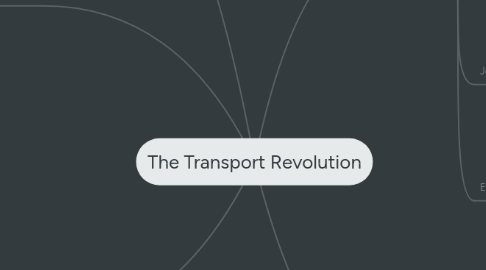
1. Canals
1.1. Moved bulky goods cheaply
1.2. Duke of Bridgewater
1.2.1. Coal transport expensive
1.2.2. James Brindley built him a canal
1.2.3. Profits rose greatly
1.3. Results
1.3.1. Bulky goods transported
1.3.2. Cheaper than carts
1.3.3. Very slow barges
2. Railways
2.1. Watt's steam engine made possible:
2.2. Steam locomotive
2.3. Adapted to run on an iron track, called the locomotive
2.4. George Stephenson
2.4.1. Invented first goods carrying train
2.4.2. Also made the Rocket, a passenger train
2.4.3. ^ average speed 25km/h
2.5. Effects
2.5.1. Fast, cheap transport
2.5.2. Heavy goods, quickly over long distances
2.5.3. Huge boost to heavy industry
2.5.4. Boosted tourism, as people could now travel to resorts
2.5.5. Fresh food in cities every day
2.5.6. Many jobs made
2.5.7. Decline in road use and canals
3. Steam ships
3.1. Late 1700s - Steam engine adapted to ships
3.2. 1843 - Brunel built Great Britain steamship
3.3. Previously - Sail power
3.4. Effects
3.4.1. Faster sea transport
3.4.2. Large cargo can be transported
4. Roads
4.1. Before...
4.1.1. Dirt tracks
4.1.2. Many breakdowns
4.1.3. Carts carried small amounts
4.1.4. Major improvements needed
4.2. Turnpike trusts
4.2.1. Private companies
4.2.2. Maintained and improved sections of road
4.2.3. Funded using tolls
4.2.4. These roads still not suitable for carts carrying heavy loads
4.3. Thomas Thelford
4.3.1. Deep foundations
4.3.2. Larger stone layer, little stone layer
4.3.3. Tightly packed gravel, gave smooth surface
4.3.4. Higher in the middle, good drainage
4.4. John MacAdam
4.4.1. No need for deep foundation - 30 cm sufficient
4.4.2. Carts ground stone to powder, powder washed down by rain and held lower layers together
4.4.3. Roads highest in middle, drained into ditches at roadside
4.5. Effects
4.5.1. Journey time reduced
4.5.2. More people travelled
4.5.3. More products could be transported - reduced transport costs
